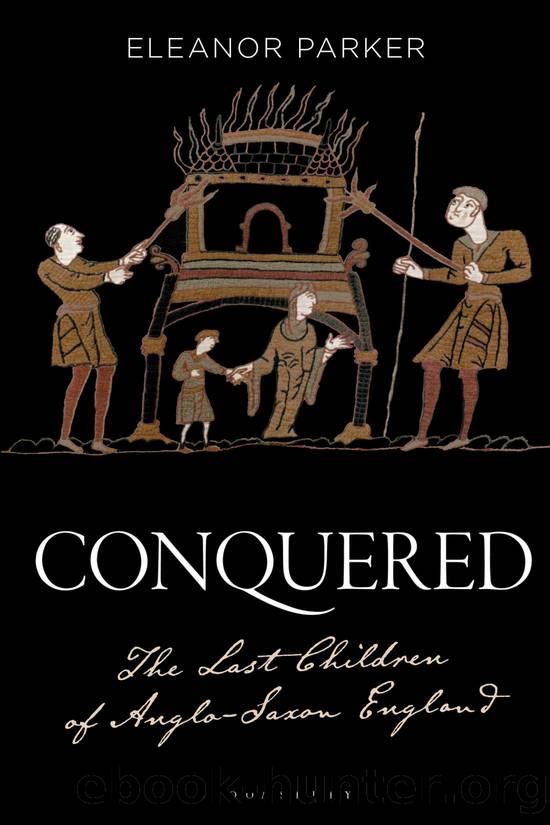Conquered by Eleanor Parker;

Author:Eleanor Parker; [Parker;, Eleanor]
Language: eng
Format: epub
ISBN: 9781350287068
Publisher: Bloomsbury
Figure 22 Crowland Abbey, the place of Waltheofâs burial. © Authorâs own.
An English martyr
As an unusual and high-profile execution, Waltheofâs death must have had an immediate impact. It is possible that when the monks of Crowland sought permission to claim his body for burial, they already recognized the possibility that he might come to be seen as a martyr (Figure 22). However, it was only in the 1090s, fifteen years or so after his death, that his saintly cult began to emerge. In 1091 Crowland suffered a serious fire in which the church was damaged, and the following year, during the process of rebuilding, Waltheofâs tomb was opened. His body was found to be intact, with the severed head rejoined to the trunk, and miracles began to be reported at the tomb â the first tokens of sainthood.
Over the next few decades, Crowland began to promote Waltheof as a martyr. Although his tomb was opened in 1092, it was still not until more than twenty years later, in the decade between c. 1114 and c. 1124, that texts were produced at the instigation of the monks in support of his claim to sanctity. Unlike Thorkellâs lament, therefore, the first written accounts of Waltheof from Crowland date from at least forty years after the earlâs death and look back on his rebellions from a period when Norman rule was firmly established in England. What they have to say about âNormanâ and âEnglishâ attitudes to Waltheof must be interpreted with this in mind. The abbot of Crowland who had brought Waltheofâs body to the abbey, Wulfketel, was deposed around 1085, and it was later suggested that this was because he was âan Englishman hated by the Normansâ.30 The two abbots who oversaw the growth of Waltheofâs cult were, however, not likely to be anti-Norman partisans. Abbot Ingulf, who presided over Waltheofâs first translation in 1092, was an Englishman by birth but had entered monastic life in Normandy at St Wandrille, while his successor, who encouraged the flowering of Waltheofâs cult in the 1110s, was Geoffrey of Orléans, formerly prior of St Ãvroul.
It was Geoffrey, who became abbot of Crowland in 1109, who saw the advantages of providing a full textual record of Waltheofâs story. He commissioned Orderic Vitalis, whom he knew from St Ãvroul, to write an account of Waltheofâs life and death, as well as of the abbeyâs early history and its other saint, Guthlac.31 Orderic stayed at Crowland while engaged in this work, drawing on written sources for the monasteryâs history as well as the oral recollections of the monks. The resulting texts were incorporated into Ordericâs Ecclesiastical History but copies also remained at Crowland, where they formed the basis of later accounts of the earlâs life. These texts provide an insight into how the monks were choosing to present their patron in the second decade of the twelfth century and in particular how they saw fit to interpret the story of his controversial death. They also allow us to
Download
This site does not store any files on its server. We only index and link to content provided by other sites. Please contact the content providers to delete copyright contents if any and email us, we'll remove relevant links or contents immediately.
4 3 2 1: A Novel by Paul Auster(12182)
The handmaid's tale by Margaret Atwood(7626)
Giovanni's Room by James Baldwin(7096)
Asking the Right Questions: A Guide to Critical Thinking by M. Neil Browne & Stuart M. Keeley(5565)
Big Magic: Creative Living Beyond Fear by Elizabeth Gilbert(5541)
Ego Is the Enemy by Ryan Holiday(5211)
The Body: A Guide for Occupants by Bill Bryson(4860)
On Writing A Memoir of the Craft by Stephen King(4809)
Ken Follett - World without end by Ken Follett(4581)
Adulting by Kelly Williams Brown(4425)
Bluets by Maggie Nelson(4420)
Eat That Frog! by Brian Tracy(4357)
Guilty Pleasures by Laurell K Hamilton(4257)
The Poetry of Pablo Neruda by Pablo Neruda(3969)
Alive: The Story of the Andes Survivors by Piers Paul Read(3905)
White Noise - A Novel by Don DeLillo(3905)
Fingerprints of the Gods by Graham Hancock(3872)
The Book of Joy by Dalai Lama(3840)
The Bookshop by Penelope Fitzgerald(3707)
